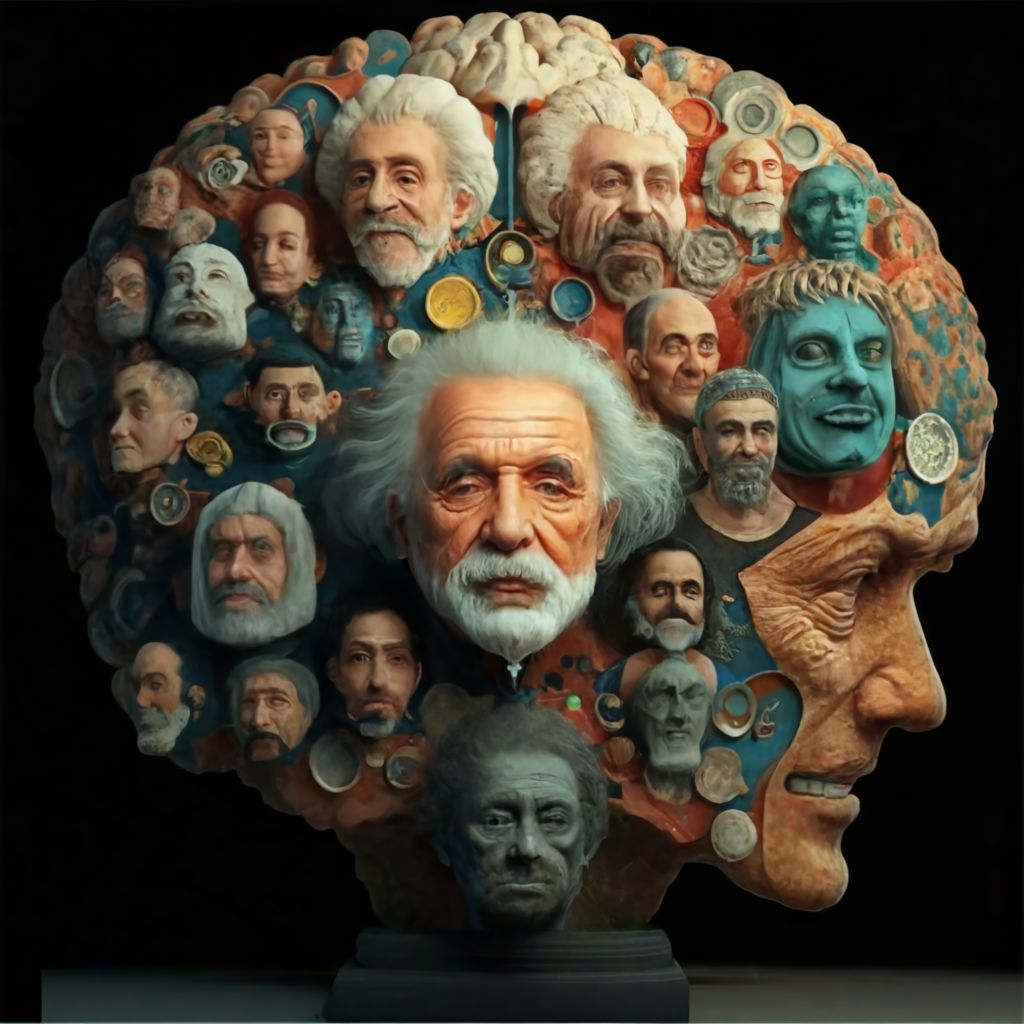By Prof. Levine & Dr. Salganik
Greetings,
Antisocial personality disorder (ASPD) is classified under cluster B of personality disorders in the American diagnostic and classification system known as DSM-5. It is diagnosed more in men than in women. This gender difference may be due to a combination of biological, social and cultural factors.
Antisocial personality disorder is characterized by a long-term pattern of manipulating, exploiting, or violating the rights of others. This disorder is often associated with criminal behavior and substance abuse, making it a significant concern in both clinical and legal settings.
ASPD is not a monolithic condition and can manifest in different forms, often overlapping with other personality disorders. Some researchers propose different subtypes based on specific traits and behaviors:
Aggressive/hostile type: characterized by open aggression, irritability and frequent physical confrontations.
Deceptive/Manipulative Type: Exhibits chronic lying, manipulation, and devious behaviors to take advantage of others.
Impulsive/Risk-Taking Type: Exhibits high impulsivity, lack of foresight, and engaging in risky behaviors without considering the consequences.
Tough/unemotional type: characterized by a deep lack of empathy, shallow emotions and a cold and detached demeanor.

AI-assisted demo
Read more »
By Prof. Levine & Dr. Salganik
שלום רב
הפרעת אישיות אנטי-חברתית (ASPD) מסווגת תחת אשכול B של הפרעות אישיות בשיטת האבחון והקלסיפיקציה האמריקאית המכונה- DSM-5. היא מאובחנת יותר אצל גברים מאשר אצל נשים. הבדל מגדרי זה עשוי לנבוע משילוב של גורמים ביולוגיים, חברתיים ותרבותיים.
הפרעת אישיות אנטי-חברתית מאופיינת בדפוס ארוך טווח של מניפולציה, ניצול או הפרה של זכויותיהם של אחרים. הפרעה זו קשורה לעתים קרובות להתנהגות פלילית ושימוש בסמים, מה שהופך אותה לדאגה משמעותית הן במסגרות קליניות והן במסגרות משפטיות.
ASPD אינו מצב מונוליטי והוא יכול להתבטא בצורות שונות, לעתים קרובות בחפיפה להפרעות אישיות אחרות. חלק מהחוקרים מציעים תת-סוגים שונים המבוססים על תכונות והתנהגויות ספציפיות:
סוג תוקפני/עוין: מאופיין בתוקפנות גלויה, עצבנות ועימותים פיזיים תכופים.
סוג רמאי/מניפולטיבי: מפגין שקרים כרוניים, מניפולציות והתנהגויות ערמומיות כדי לנצל אחרים.
טיפוס אימפולסיבי/לקיחת סיכונים: מפגין אימפולסיביות גבוהה, חוסר ראיית הנולד ומעורבות בהתנהגויות מסוכנות מבלי לקחת בחשבון את ההשלכות.
טיפוס קשוח/לא רגשי: מאופיין בחוסר אמפתיה עמוק, רגשות רדודים והתנהגות קרה ומנותקת.

הדגמה בעזרת AI
Read more »
By Prof. Levine & Dr. Salganik
Greetings to our readers
We assume that the individual's "social self" consists of the internalization of influential figures in one’s life, arranged in a hierarchical order [the group of these internalizations we metaphorically called the board of internal figures], where one or more internalized figures have the greatest influence on the individual's attitudes, feelings and behavior, which we called "the leader self" [a character who in the past was also called "the dictator self," see previous conversations]. It is possible that, similar to short-term memory, parts of which are transferred to long-term memory, even with regard to the internalization of characters, there is a short-term internalization that, depending on the circumstances, the importance and duration of the character's influence, will eventually be transferred to long-term internalization in the directorate of internalized characters.
Below we will discuss the structure of the social self: it consists of "secondary selves" which include the following types: 1) a variety of "self-representations" that originate from attitudes and feelings towards the self and its representations in different periods of life 2] representations of internalized figures that originate from the significant figures that the person is exposed to during his life, but as mentioned, there may also be imaginary characters represented in books, movies, etc. that have had a great impact on the person. 3] internalized representations of "subculture" [subculture refers to social influences in the environment in which a person lives and are not necessarily related to a specific person].

AI assisted picture: Board of Internalized Characters. The large figure expresses the internalized inner leader
Such a theoretical background in which the "social self" of the individual consists of internalizations of influential figures arranged in a hierarchical order, can perhaps explain processes in the author's creative process, as a process influenced by the dynamics of such an internalized hierarchy of figures in the writer's soul, which we called as mentioned in the metaphor "directorate of internalized characters" or "the board of the internalized characters".
Read more »
By Prof. Levine & Dr. Salganik
שלום רב לקוראנו
אנו מניחים ש"העצמי החברתי" של הפרט מורכב מהפנמה של דמויות משפיעות בחייו, המסודרות בסדר היררכי [קבוצת הפנמות אלו כינינו במטפורה דירקטוריון או מנהלת הדמויות הפנימיות] , כאשר לדמות מופנמת אחת או יותר יש את ההשפעה הגדולה ביותר על עמדותיו, רגשותיו והתנהגותו של הפרט, שקראנו לה או להם "המנהיג/ים העצמי/ים" [ דמות שבעבר כונתה גם "הדיקטטור העצמי," ראו שיחות קודמות]. יתכן שבדומה לזיכרון קצר מועד שחלקים ממנו מועברים לזיכרון ארוך טווח אף לגבי הפנמת דמויות קיימת הפנמה קצרת טווח שבתלות בנסיבות, בחשיבות ומשך זמן השפעת הדמות, זו תועבר להפנמה ארוכת טווח בדירקטוריון הדמויות.
להלן נדון במבנה העצמי החברתי: הוא מורכב מ"עצמיים משניים" הכוללים את הסוגים הבאים: 1) מגוון "יצוגיי האני" שמקורם בעמדות וברגשות כלפי העצמי וייצוגיו בתקופות שונות בחיים 2] ייצוגים של דמויות מופנמות שמקורן בדמויות המשמעותיות שהאדם נחשף אליהן במהלך חייו, אבל כאמור ייתכנו גם דמויות דמיוניות המיוצגות בספרים, סרטים וכו' 'שהשפיעו מאוד על האדם. 3] ייצוגים מופנמים של "תת-תרבות" [תת-תרבות מתייחסת להשפעות חברתיות בסביבה בה האדם חי ואינן קשורות בהכרח לאדם מסוים].

איור בעזרת AI: דירקטוריון הדמויות המופנמות. הדמות הגדולה מבטאת את המנהיג הפנימי המופנם
רקע תיאורטי כזה שבו "העצמי החברתי" של הפרט מורכב מהפנמות של דמויות משפיעות המסודרות בסדר היררכי, יכול אולי להסביר תהליכים בהליך היצירה של הסופר, כתהליך המושפע מהדינמיקה של היררכיה מופנמת כזו של דמויות בנפשו של הסופר, שכינינו אותה כאמור במטפורה "דירקטוריון הדמויות המופנמות" או "מנהלת הדמויות המופנמות".
Read more »
By Prof. Levine & Dr. Salganik
Mythology usually refers to a collection of stories and poems related to the ancient traditions of a particular group of people, nation or culture, and deals mainly with the plots of human gods and gods, animals and a variety of imaginary creatures.

Mythology – illustration with the help of AI
It is possible and mythological thinking was born due to the need to deal with the anxiety caused by the events of nature and life that are perceived as incomprehensible and meaningless. Myths were probably created in order to explain them, to find meaning, direction and even guidance in them. Thus, starting with the primitive man, nature was personified and perceived as threatening figures. In fact, it can be said that there was a personification and projection from the mind of the forces of nature as destructive and threatening figures. When this was first brought up through stories that constitute the beginning of the myth, there was a need to calm down and deal with the destructive and threatening narrative representations of the forces of nature. The story of the myth has now expanded to include positive characters, plot heroes who were even omnipotent.
Read more »
By Prof. Levine & Dr. Salganik
מיתולוגיה מתייחסת בדרך כלל לאוסף של סיפורים ושירים הקשורים במסורות הקדומות של קבוצת אנשים, עם או תרבות מסוימת, ועוסקים בעיקר בעלילותיהם של בני אנוש אלים ובני אלים חיות ומגוון יצורים דמיוניים.

מיתולוגיה- איור בעזרת AI
אפשר והחשיבה המיתולוגית נולדה בשל הצורך להתמודד עם החרדה הנגרמת ע"י אירועי הטבע והחיים הנתפסים כלא מובנים כחסרי הגיון. המיתוסים נוצרו כנראה בכדי להסביר אותם, למצוא בהם משמעות כיוון ואף הדרכה. כך, החל מהאדם הקדמון הטבע הואנש ונתפס כדמויות מאיימות. בעצם ניתן לומר כי חלה האנשה והשלכה מן הנפש החוצה של כוחות הטבע כדמויות מאיימות הרסניות וקשות. כשהדבר הועלה תחילה באמצעות סיפורים המהווים ראשיתו של המיתוס, נוצר צורך כנראה לאזנן על מנת להפחית את החרדה ולהתמודד עם הייצוגים הסיפוריים ההרסניים והמאיימים של כוחות הטבע. סיפור המיתוס התרחב כעת לכלול גם דמויות חיוביות, גיבורי עלילות שהיו אף כל יכולים, כאשר הנרטיב של סיפור המיתוס מקשר ביניהן.
Read more »
By Prof. Levine & Dr. Salganik
נשאלת השאלה מהם התהליכים הפסיכולוגיים המובילים אמנים ליצור אמנות?
ככלל, התהליכים הפסיכולוגיים המובילים אמנים ליצור אמנות הם רבי פנים ויכולים להיות מושפעים משילוב של גורמים פנימיים וחיצוניים. הנה כמה תהליכים פסיכולוגיים מרכזיים מעורבים:
1. מוטיבציה פנימית
ביטוי אישי: אמנים יוצרים לעתים קרובות אמנות כאמצעי להביע את מחשבותיהם, רגשותיהם וחוויותיהם. מוטיבציה פנימית זו נובעת מצורך עמוק לתקשר ולבטא את מה שעשוי להיות קשה להעביר באמצעות מילים.
שמחה וסיפוק: מעשה יצירת האמנות יכול להביא שמחה וסיפוק רבים, הגשמת רצון פנימי לביטוי עצמי ולהישגים.
2. תהליכים קוגניטיביים
פתרון בעיות: יצירת אמנות כרוכה לעתים קרובות בפתרון בעיות מורכבות הקשורות לקומפוזיציה, צבע, איזון וצורה. זה מעסיק את היכולות הקוגניטיביות של האמן, מגרה יצירתיות וחשיבה חדשנית.
מצב זרימה: אמנים רבים חווים מצב של זרימה, שבו הם שקועים לחלוטין בעבודתם. מצב זה של מוטיבציה ממוקדת משפר את יכולתם ליצור ויכול להיות מתגמל מאוד.
3. תהליכים רגשיים
ויסות רגשי: אמנות יכולה לשמש פורקן טיפולי, המסייע לאמנים לנהל ולווסת את רגשותיהם. על ידי תיעול רגשותיהם לעבודתם, אמנים יכולים להשיג תחושה של קתרזיס.
תהודה רגשית: אמנים שואפים לעתים קרובות לעורר רגשות בקהל שלהם. הרצון להתחבר עם אחרים ברמה הרגשית יכול להניע את תהליך היצירה.
4. גורמים פסיכודינמיים
דחפים לא מודעים: על פי תיאוריות פסיכודינמיות, דחפים ותשוקות לא מודעים יכולים להשפיע באופן משמעותי על היצירה האמנותית. אמנות יכולה להיות דרך לאמנים לחקור ולהביע מחשבות וקונפליקטים לא מודעים.
גיבוש זהות: אמנות יכולה למלא תפקיד מכריע בפיתוח וחיזוק זהותו של אמן, לספק תחושה של מטרה ומשמעות.
5. השפעות חברתיות ותרבותיות
נרטיבים תרבותיים: אמנים מושפעים לעתים קרובות מהנרטיבים התרבותיים והחברתיים שהם נחשפים אליהם. עבודתם יכולה לשקף, לבקר או לתרום לנרטיבים אלה.
קהילה ומשוב: אינטראקציה עם אמנים אחרים והקהל יכולה לספק משוב, אימות והשראה, ולהניע עוד יותר את תהליך היצירה.
6. גורמים התפתחותיים וסביבתיים
חוויות מוקדמות: חוויות חיים מוקדמות, כולל חשיפה לאמנות ועידוד מאחרים משמעותיים, יכולות לעצב באופן עמוק את נטייתו של הפרט ליצירה אמנותית.
גירויים סביבתיים: סביבת האמן, כולל החלל הפיזי, החומרים הזמינים והאירועים הנוכחיים, יכולה להשפיע על תהליך היצירה והתפוקה שלו.
7. תכונות פסיכולוגיות
פתיחות לחוויה: אמנים לעתים קרובות מקבלים ציון גבוה על תכונת הפתיחות לחוויות, הקשורה ליצירתיות, סקרנות ונכונות לחקור רעיונות וחוויות חדשות.
חוסן: היכולת להתמיד באתגרים ובמכשולים היא קריטית לאמנים, ומאפשרת להם להמשיך ליצור למרות הקשיים.
8. היבטים נוירו-מדעיים
תפקוד המוח: אזורים מסוימים במוח, כגון קליפת המוח הקדם-מצחית ורשת ברירת המחדל, מעורבים בחשיבה יצירתית וביצירת רעיונות אמנותיים. נוירופלסטיות גם משחקת תפקיד, שכן המוח מסתגל ויוצר קשרים חדשים באמצעות הפרקטיקה של אמנות.
לסיכום, יצירת אמנות היא יחסי גומלין מורכבים של מוטיבציות פנימיות, תהליכים קוגניטיביים ורגשיים, השפעות פסיכודינמיות, גורמים חברתיים ותרבותיים, תנאים התפתחותיים וסביבתיים, תכונות פסיכולוגיות והיבטים נוירו-מדעיים. המסע של כל אמן הוא ייחודי, מעוצב על ידי שילוב של אלמנטים אלה.

אמנים בפעולתם: הדמיה בעזרת AI
Read more »
By Prof. Levine & Dr. Salganik
Greetings,
Today we want to talk about a topic that is important to many people. Many people want to lose weight, quite a few people want to start eating healthy or there may be someone who wants to start a vegetarian or vegan diet, quite a few people want to make a commitment to themselves and start doing sports, quite a few people promise themselves that they will join a certain workshop, or want to stop smoking or change habits, unfortunately for the most part things do not go well and if they do then only for a short period of time.
On the other hand, but interestingly, there are people who report that there are certain situations where they managed to change a habit such as quitting smoking and so on.
So an intriguing question remains here: what is behind the ability or inability to change habits?
Let's first define what a habit is: a habit is a regular practice or routine that is performed frequently, and in many cases, automatically. It is a pattern of behavior that develops through repetition and becomes ingrained, often to the point where it is carried out without conscious thought. Habits can be positive, such as exercising regularly or brushing your teeth, or negative, such as smoking or procrastination. They are created in a process where behavior is reinforced over and over again until it becomes a natural part of everyday life.
PICTURE 1

Illustration: "Yeremiah…want to change your habit? Here's an instruction book…"
Read more »
By Prof. Levine & Dr. Salganik
שלום רב
היום אנחנו רוצים לדבר על נושא שהוא חשוב ללא מעט אנשים. הרבה אנשים רוצים לרזות, לא מעט אנשים רוצים להתחיל לאכול בריא או יכול להיות מישהו שרוצה להתחיל דיאטה צמחונית או טבעונית, לא מעט אנשים רוצים להתחייב לעצמם ולהתחיל לעשות ספורט, לא מעט אנשים מבטיחים לעצמם שהם יצטרפו לסדנה מסוימת, או רוצים להפסיק לעשן או לשנות הרגלים מסוימים ועל פי רוב או לא פעם הדברים לא עולים יפה ואם כן אז רק לתקופה קצרה.
מצד שני, אבל באופן מעניין, יש אנשים שמדווחים שהנה יש מצבים מסוימים שהם הצליחו לשנות איזה הרגל כמו הפסקת עישון וכך הלאה.
אזי ונשארת כאן שאלה מעניינת: מה עומד מאחורי היכולת או אי היכולת לשנות הרגלים?
נגדיר תחילה הרגל מהו: הרגל הוא תרגול קבוע או שגרה המבוצעת לעתים קרובות, ובמקרים רבים, באופן אוטומטי. זהו דפוס התנהגות המתפתח באמצעות חזרה והופך מושרש, לעתים קרובות עד לנקודה שבה הוא מתבצע ללא מחשבה מודעת. הרגלים יכולים להיות חיוביים, כגון פעילות גופנית באופן קבוע או צחצוח שיניים, או שליליים, כגון עישון או דחיינות. הם נוצרים בתהליך שבו התנהגות מתחזקת שוב ושוב עד שהיא הופכת לחלק טבעי מחיי היומיום.

איור: "ירמיהו…רוצה לשנות הרגל? הנה לך ספר הדרכה…."
Read more »
By Prof. Levine & Dr. Salganik
In our model, the self includes most of the components of the human soul. The model distinguishes between the "primary self", or the "initial self" which is in fact the basic biological core consisting of a number of innate structures and subject to increasing development during life, this self includes the instinctive emotional and cognitive parts of the person. The exact structure of the primary self and the relationships between its parts still require clarification [see previous conversations]. The primary self uses the memory stores and the abilities of cognition, emotion and more.
On the other hand, the "social self" [consisting of "secondary selves"] is built throughout life, and represents an epistructure that gradually develops from the primary self during the person's exposure to social influence, and consists of the internalization of figures significant to the person, originating from external groups or even imaginary groups (related , for example, to a story, a myth, a movie, etc.) which greatly influenced the person.
It is possible that this social self will also include the personification of objects and agencies most important to a person. We note here that only parts of the self are conscious, while other parts are not. Usually the person is not aware of the fact that the social self consists of influential internalized characters that dictate his attitudes and behavior and recognizes these as arising from his own will.
Below we will discuss the structure of the social self: it consists of "secondary selves" which include the following types: 1) the variety of representations of the "Me" that originate from attitudes and feelings towards the self and its representations at different periods in life 2] representations of internalized figures that originate from the significant figures that the person is exposed to during his life , but as mentioned there may also be imaginary characters represented in books, movies, etc. that had a great impact on the person. 3] internalized representations of "subculture" [subculture refers to social influences in the environment in which a person lives and are not necessarily related to a specific person].

AI-assisted illustration: The Board of Internalized Characters. The large figure expresses the internalized dictator-self
We refer to the social self metaphorically as the "directorate of characters" or more precisely the "directorate of internalized characters." We note that in this internalized board of directors there is usually a hierarchy in which there are more influential and dominant figures that we metaphorically called the "dictator-self or selves" and these figures set the tone and even censor and determine which content, attitudes and behaviors can be included in the board of directors. As mentioned, we will point out again that the person as a whole is not usually aware of the influence of the internalized character board and recognizes its influence as arising from his own desires and attitudes.
We will also note that, as a general rule, the board of directors is very dynamic and there are constant struggles and power relations between the internalized characters that make it up regarding the positions they will express, with the dictator-self or -selves usually dictating the tone.
This is how you can internalize various external characters that influence the person in the "directory of internalized characters", but we will emphasize again that usually the most important internalization is that of what we called the "dictator-self". Here it is about internalizing a character that has a great influence and shapes the person for good and/or bad, that has a great influence on the panel of internal characters that build the social self.
The dictator-self’s attitudes play a central role in making decisions about internalizing information and characters. He decides whether to reject the internalization or, if accepted, in what form it will be internalized. In other words, in a sense, we assume that this influential figure is also a form of internal censorship.
It should be emphasized that these are not concrete hypotheses regarding the presence of internalized figures in the inner world of the individual as a sort of "little people inside the brain", but rather in their representation in different brain areas whose nature and manner of representation still requires further research.
We will also note that although we call this character a "dictator", with the exception of a certain type, its characteristics are not the same as those of a dictatorial ruler in a certain country, but rather that this character is dominant and influential among the "characters’ board".
This model therefore holds that the social self consists of "internalized key figures [usually human], usually referring to the significant people in a person's life who have played a central role in shaping the individual's beliefs, values and self-concept. These figures may include family members, friends, mentors , teachers or any other influential person who left a lasting impression on the person. Sometimes, these will also include historical, literary and other figures who left a noticeable mark on the person and were internalized by him.
The term "internalized" implies that the influence of these key figures has been absorbed and integrated into the individual's thoughts, attitudes, and behaviors. This internalization occurs through the process of observing, interacting with, and learning from these important people. As a result, the individual may adopt certain values, perspectives, and approaches to life that reflect those of the influential figures.
These internalized figures can serve as guiding forces in decision-making, moral thinking and emotional regulation. Positive influences can contribute to a person's well-being, security and resilience, while negative influences can lead to internal conflicts or challenges in personal development.
Read more »

 Prof. Joseph Levine, M.D. is an emeritus associate professor in the Division of Psychiatry, Faculty of Health Sciences, Ben Gurion University in Israel. Prof. Levine is a certified psychiatrist with clinical experience in controlled trials of adult psychiatric disorders and in psychotherapy. He was awarded a NRSAD independent investigator grant for the study of Creatine Monohydrate in psychiatric disorders -- mainly Schizophrenia. He resides and treats patients in Tel Aviv and all of central Israel.
Prof. Joseph Levine, M.D. is an emeritus associate professor in the Division of Psychiatry, Faculty of Health Sciences, Ben Gurion University in Israel. Prof. Levine is a certified psychiatrist with clinical experience in controlled trials of adult psychiatric disorders and in psychotherapy. He was awarded a NRSAD independent investigator grant for the study of Creatine Monohydrate in psychiatric disorders -- mainly Schizophrenia. He resides and treats patients in Tel Aviv and all of central Israel.








